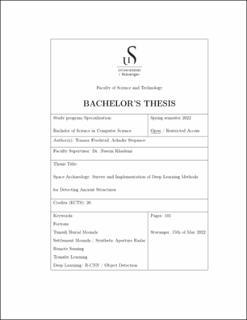| dc.description.abstract | Remote sensing instruments are changing the nature of archaeological work.
No longer are archaeological discoveries done by field work alone. Light
Detection and Ranging, or LiDAR, optical imagery and different types of
satellite data are giving opportunities for archaeological discoveries in areas
which might be inaccessible to archaeologists. Different types of machine
learning and deep learning methods are also being applied to remote sensing
data, which enables automatic searches to large scale areas for detection of
archaeological remains.
In this thesis faster R-CNN object detection deep learning frameworks were
used to train models and apply these to three types of archaeological remains. LiDAR based Digital Terrain Models were used to identify burial
mounds in Norway. Optical imagery was used to identify fortress structures in Central Asia. Synthetic Aperture Radar data, or SAR, was used to
detect archaeological settlement mounds in Central Asia. The success and
limitations of these models are presented. | |
